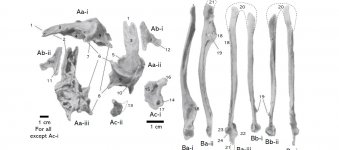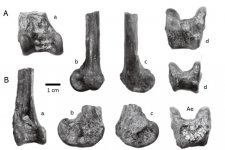SYSTEMATIC PALEONTOLOGY
Class AVES Linnaeus, 1758
Order ANSERIFORMES Wagler, 1831
Family ANATIDAE Leach, 1820
Subfamily ANSERINAE Vigors, 1825
Tribe CYGNINI Vigors, 1825
Genus Annakacygna Hiroshige et Yoshikazu, 2022
Type Species— Annakacygna hajimei, sp. nov.
Included Species— Type species and A. yoshiiensis, sp. nov.
Etymology— Combination of Annaka, the city name of type locality, and cygna, the feminine of Latin cygnus, swan.
Diagnosis— Large-sized anatid with a relatively big head, relatively reduced pectoral skeleton that is characterized by the combination of the following osteological features: cranium-wide fossa temporalis, presence of "pseudo-sagittal crest", presence of salt gland impression; lacrimal- unfused to the frontal of neurocranium; quadrate- deep impression of m. adductor mandibulae externus profundus on the lateral surface; mandible- curved strongly, long for the body, the longitudinal structure on the articular facet for quadrate; ribs- the uncinate process unfused; sternum- carina sterni reduced; scapula- small facies articularis humeralis and acromion, curved and wide corpus scapulae with developed and round extremitas caudalis; humerus- long and straight, as long as its trunk, short crista pectoralis, developed crista bicipitalis with prominent tubercules for the accessory origin of m. biceps brachii at just distal to tuberculum ventrale and the insertion of m. scapulohumeralis caudalis at the middle, small distal end; ulna- short relative to the humerus, only 57% of humeral length; radius- same as ulna short relative to the humerus, widens and flattened distally; radiale- huge relative to the wing, triangular profile in dorsoventral view, acts to limit the mobile range of wrist joint to bending posture; carpometacarpus- short and robustly build, large proximal end with strong insertion of the m. ulnimetacarpalis ventralis; pelvis- wide as a swan's, distal caudal vertebrate unfused, caudal termination of pubis deep; tibiotarsus- crista cnemialis cranialis broad and squared and extend proximally and less anteriorly, condylus lateralis and condylus medialis of distal end narrow laterally, incisura intercondylaris wide; tarsometatarsus- shaft laterally narrow. All long bones are pachyost
Annakacygna hajimei Hiroshige et Yoshikazu, 2022
aff. Megalodytes sp.: Matsuoka et al., 2001
Holotype— GMNH-PV-678, nearly complete associated but disarticulated skeleton collected January 1, 2000 by Mr. Hajime Nakajima. The specimen was collected as a large slab of siltstone (ca. 73 x 45 cm) with the bones scattered in the bedding plane (Matsuoka et al. 2001). The individual elements were then removed completely from the matrix so that they could be studied three dimensionally (Matsuoka et al. 2004). Certain elements are in nearly pristine condition, while others have suffered varying degrees of crushing and compressional distortion. The fossilized elements include: the cranium (greatly crushed); left quadrate lacking most of the orbital process; mandible lacking some portion of the symphysial area and parts of the retroarticular processes; cervical vertebrae interpreted as the 3rd-5th and 15th-23rd; thoracic vertebrae interpreted as the 1st-2nd and 5th-7th; three caudal vertebrae; pelvis with separated posterior ends of pubes; an assortment of thoracic and sternal ribs and uncinate processes, mainly from the left side; poorly preserved sternum consisting mainly of a portion of the posterior part of the carina; very poorly preserved right coracoid consisting mainly of the ventral surface imbedded in fiberglass resin; left scapula (there is no remaining part of the clavicles, if they were ossified); right and left humeri; right and left ulna, the left one is complete in length but crushed, right ulna preserved mainly as resin mold; left radius; left radiale; left carpometacarpus; left phalanx one of major alar digit; right and left femora (crushed); complete left and proximal half of right tibiotarsi; left tarsometatarsus; pedal phalanx 1 of left digit IV.
Type Locality and the geologic horizon— Near Haraichi, Annaka City, Gumna Prefecture, Japan (Fig. 1-C-point 1). The river floor of the Usui River, about 600 m down the river from the Nakahashi Bridge. 36°18'46.6"N, 138°52'07.0"E. From the middle part of Haraichi Formation, Annaka Group. About 11.5 Ma.
Measurements of Holotype in mm— Cranium: maximum length as preserved 95, least width of interorbital bridge 13.6; Mandible: greatest length 105, depth at coronoid process 17.2, depth of dentary at midpoint 6.8; Pelvis: greatest length (without pubis) 200; Sternum: maximum length as preserved 105; Scapula (left): greatest length 108, anterior width 20.8, length of glenoid facet15.1, shaft width and depth posterior to articulation 9.8 x 5.5; Humerus (right): greatest length 220, proximal width 39.9, width and depth of shaft at midpoint 9.5 x 10.3, distal width 22.2; Humerus (left): greatest length 218, proximal width 37.8, width and depth of shaft at midpoint 10.0 x 10.9, distal width 22.2; Ulna (right): greatest length 125; Ulna (left): greatest length 124, proximal depth 14.9, proximal width 15.1, distal depth 14.9; Radius (side?): greatest length 115; Radiale: maximum diameter 22.0; Carpometacarpus (left): greatest length 66, proximal depth 25.4, width of trochlea 12.7, length of alular metacarpal 16.6, distal de;pth 9.2, distal width 8.3; Phalanx 1 of major alar digit: length 24.5; Femur (right): greatest length 97, maximum proximal width 28.6+, maximum diameter of head 12.0, distal width 25.5+; Femur (left): greatest length 94, maximum proximal width 27.0+, maximum diameter of head 12.1, distal width 24.1+; Tibiotarsus (left): greatest length (including cnemial crest) 200, length from proximal articular surface to distal end 190.5, proximal width (articular surface) 21.8, length of fibular crest 41.6, width and depth of shaft 40 mm from distal end 11.0 x 8.7, distal width 21.8, depth of external condyle 20.3, depth of internal condyle 22.4; Fibula: width and depth of head 6.4 x 16.0; Tarsometatarsus (left): greatest length 110, proximal width, maximum proximal depth through hypotarsus 24.4, width and depth of shaft at midpoint 9.4 x 11.6, width through trochleae 19.2+, width and depth of trochlea II 7.6 x 14.4, width and depth of trochlea III 9.1 x 16.2, width and depth of trochlea IV 6.8 x 1
Etymology— After local paleontologist Mr. Hajime Nakajima, in recognition of his outstanding contributions to vertebrate paleontology of Gunma.
Diagnosis— As for genus
Fred
Figure 1. The skull elements (A) and mandible (B) of the holotype of Annakacygna hajimei. Aa, the neurocranium (Aa-i, left lateral; Aa-ii, dorsal; Aa-iii, ventral views); Ab, the right lacrimal (Ab-i, dorsolateral; Ab-ii, ventromedial views); and Ac, left quadrate (Ac-i, lateral, twice magnification than other figures; Ac-ii, medial views). Ba, the right lower mandible (Ba-i, lingual; Ba-ii, buccal; Ba-iii, ventral; Ba-iv, dorsal views); Bb, the left lower mandible (Bb-i, ventral; Bb-ii, dorsal views). 1, nasofrontal joint; 2, articular surface to the unfused lacrimal (on the lateral surface of frontal); 3, frontals; 4, orbit; 5, salt gland impression; 6, postorbital process; 7, fossa temporalis; 8, ala tympanica; 9, origin of m. depressor mandibula; 10, "pseudo-sagittal crest"; 11, articular surface to frontal; 12, ventral process = attaching surface of lig. prefrontomandibulare; 13, orbital process; 14, quadratojugal articulation; 15, origin of m. adductor mandibulae externus profundus; 16, capitulum oticum; 17, articular surface to the mandible; 18, coronoid process (proc. coronoideus); 19, lateral coronoid process (LCP); 20, pars symphysialis; 21, retroarticular process; 22, internal articular process; 23, external articular process; 24, articular surface






